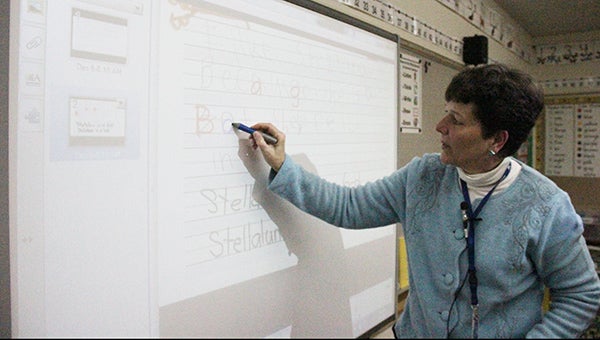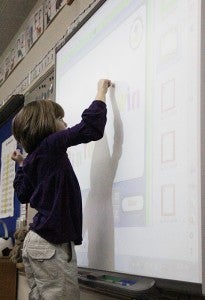Smarter boards, smarter kids
Published 5:30 pm Monday, March 18, 2013

First-grade teacher Peggy Bennett writes on a scan of a student’s handwriting homework using the Smart Board. In this way, she is able to show students best handwriting practices, which is just one of thousands of ways the technology can be used. –Kelli Lageson/Albert Lea Tribune
Forget chalkboards.Teachers say students are more attentive with the modern technology
Sibley Elementary School first-grade teacher Peggy Bennett said using a Smart Board allows her to easily get and keep the attention of her students.
“Students listen a lot more,” Bennett said. “I love it and the kids love it.”
Especially with reading, Bennett said it is powerful when students are able to visually see an object and then sound out the letters that make the name of the object.
What is a Smart Board?
The large boards have four special markers and an eraser included. A projector mounted on the classroom ceiling projects the teacher’s computer screen onto the board. The entire Smart Board screen is sensitive to touch. Bennett said one of her favorite features is that videos and sounds can be played, too.

A student in Peggy Bennett’s first-grade class at Sibley
Elementary School uses a Smart Board to practice spelling.
“The poor way to use it is using it as an overhead projector,” Bennett said.
Bennett said the optimal way to use the Smart Boards are to plan lessons around all the various activities that are available.
A feature for every subject
Bennett said the opportunities for interactive activities are endless with the Smart Board. She has lessons built around using the technology for reading, math and handwriting, just to name a few. But, in her research she’s also found that there are lots of other fun tools that don’t apply to her first-grade level lessons like using advanced math tools and other activities for older students.
Niebuhr said many teachers use the Smart Boards in morning meetings at the elementary schools. There’s applications where students can look at the weather, and the class as a group can sing a song and follow along with the words on the screen.
Startup time
Now that Bennett and other district teachers have been using the technology for years, there is much less time involved in planning lessons. Teachers who have found successful lessons share with each other and personalize them to their classrooms. Bennett said when she first started making lessons using the Smart Board that it took her four to five extra hours a week, but now it takes her much less time because the foundation work is already done.
2006
The Albert Lea School District first got Smart Boards — about a handful — in 2006. Seven years later there are 140. There are 20 or more Smart Boards in the elementary schools alone. Southwest Middle School has about 20, and Albert Lea High School has less than 20 but also use other forms of technology.
Too many uses to count
Smart Boards obviously take the place of a traditional blackboard or dry-erase whiteboard. But they also take the place of document and video projectors. Bennett can access the Internet on her Smart Board, and she can also include videos in her lesson plans. The video pops up, she presses play, and a lot of time is saved.
Students love being able to touch the screen, so Bennett tries to break them up into small groups so each can have turns interacting with lessons. But the technology can also be easily used for large-group lessons, too.
Training teachers
Since Bennett was one of the first teachers to get a Smart Board, she had many teachers visit her classroom to see it in action. She also training other teachers who were interested in the technology.
“Training is really the key factor,” Bennett said.
She said she’s glad the district got a few Smart Boards at a time. Once teachers saw what the technology could do, then they were more motivated to take the time to invest into creating lessons once they were able to get a Smart Board for their classroom.
Cost is an issue
Like any spendy technology, Smart Boards are not cheap. The district’s media coordinator, Kathy Niebuhr, said over the years the prices have changed, but that most Smart Boards were around $2,000. Niebuhr said the district did buy many of them, but that the teaching staff applied for grants that paid for some of the Smart Boards.
“Teachers who really want something find ways to make it happen,” Niebuhr said.
Special education
Niebuhr said special education classes across the district have found great success when using Smart Boards.
“They’re truly interactive,” Niebuhr said.
Especially for those special education students for whom the act of writing is difficult, they can use the Smart Board to move letters around and still be able to practice spelling without the act of writing. Special education teacher Paula Buendorf said that even the students who have severe communication or motor skills issues can use the technology.
“It’s a very accessible piece of equipment,” Buendorf said.
She estimates it’s used consistently for about 30 percent of the day, but there are some days that exceed that, too. She has designed hundreds of lessons for the Smart Board.
Teaching without technology
Though many classrooms use this interactive piece of technology, Niebuhr and Bennett both said that teaching without technology is still important. Bennett estimated she uses the Smart Board for about 60 percent of the day, but students are still doing work on paper and with physical objects.
“We talk about the balance of technology,” Niebuhr said.
With second-graders using Apple iPads, and more students in elementary schools having access to touch-screen iPods, administrators are concerned about how much is too much. But Niebuhr said students are still using print books, and she doesn’t expect that to change in the near future.
Making their own Smart Board
Because Smart Boards are around $2,000, the district hasn’t been able to purchase one for each classroom. But there are cheaper ways to make interactive white boards. Niebuhr said some high school teachers found a technology called Smoothboard, which is similar to Smart Boards. All that’s needed is a flat surface, a projector, a Nintendo Wii remote and an infrared pen. That whole cost is around $300.
“It’s another option,” Niebuhr said.

